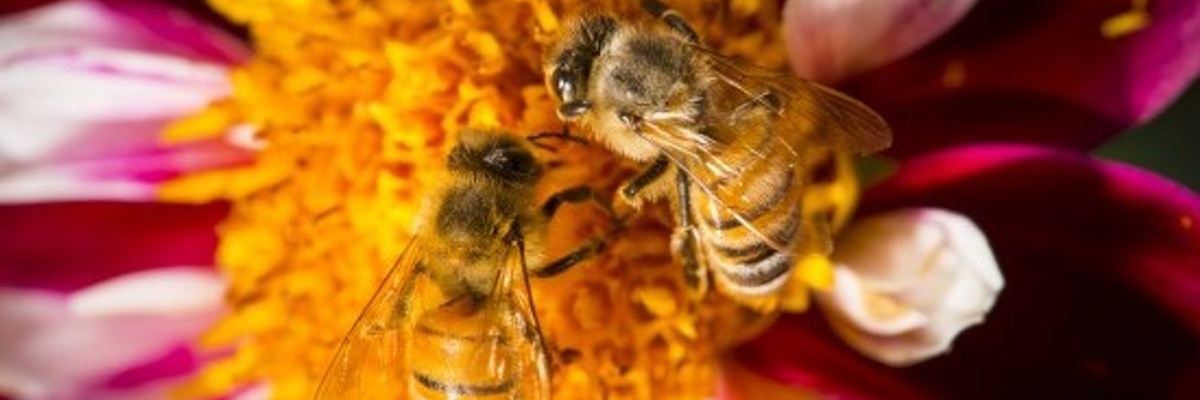

Whether you are a farmer of many acres, land manager of a large tract of land, or a gardener with a small lot, you can increase the number of pollinators in your area by making conscious choices to include plants that provide essential habitat for bees, butterflies, moths, beetles, hummingbirds, and other pollinators. Happy planting!
Whether you are a farmer of many acres, land manager of a large tract of land, or a gardener with a small lot, you can increase the number of pollinators in your area by making conscious choices to include plants that provide essential habitat for bees, butterflies, moths, beetles, hummingbirds, and other pollinators. Happy planting!
Here comes the second round of caterpillars and another chrysalis!
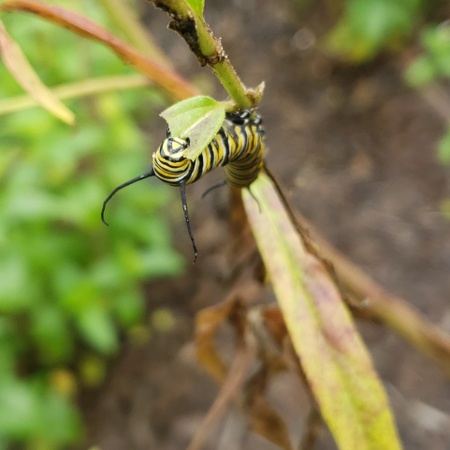

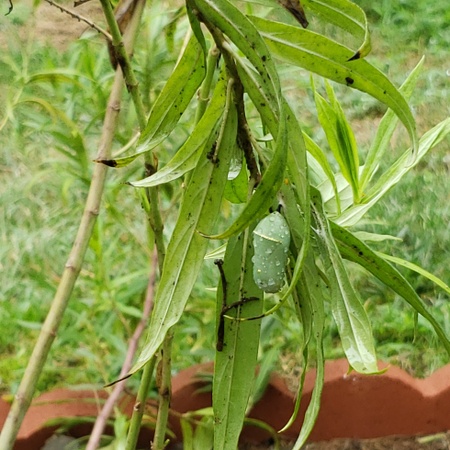
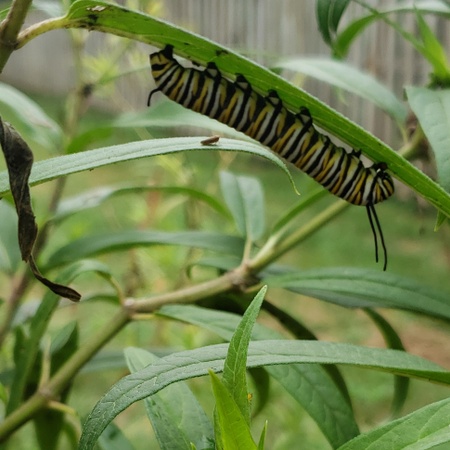
The butterfly hung suspended from its chrysalis, allowing its wings to dry and harden in the sun.
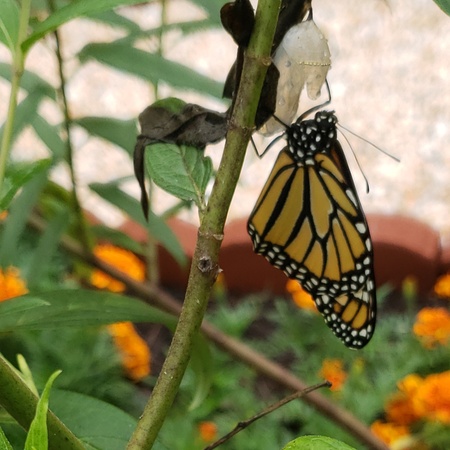

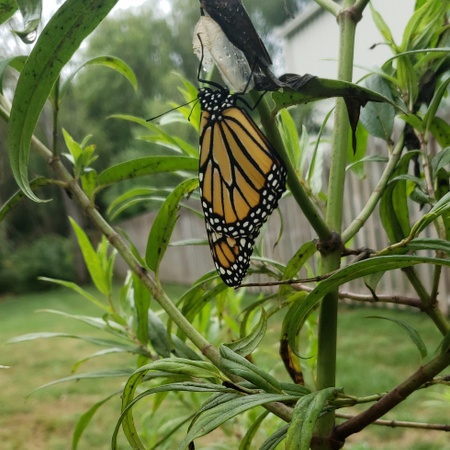

This morning we found our first Monarch emerging from its chrysalis.

We are happy to see that our chrysalis has survived the torrential rains. the countdown continues...

Today we found our first chrysalis on the milkweed. It is a gorgeous jade color and is only about an inch long. Inside the chrysalis, the caterpillar mouth parts will be reformed so that the emerging butterfly will have no chewing mouth parts. Instead, it will have a proboscis, which is similar to a straw, and will be used to sip nectar. It will no longer eat solid foods. The emerging butterfly will have 3 pair of legs, not eight like it did as a caterpillar. All of this will happen within 10 - 14 days. How exciting!

But wait...it seems there is a second round of caterpillars coming our way! We spotted another one munching leaves today.

Our garden is quite popular with hummingbird moths. Here is another clearwing we spotted. Notice that he is more green in color and its wings are not as see through as the others we have seen.

Looks like the ironweed is preparing to bloom. So many blossoms at the ready.

Vernonia is such a fantastic plant! The foliage is soft and fine and the plant maintains a rounded shape all season. In the garden, it resembles amsonia hubrichtii but on a smaller scale. I'd grow it for the foliage alone. It has a very deep taproot - site it carefully in your garden and never try to move it. Thanks to the deep root system, it is remarkably drought resistant. The foliage stays fluffy and green all summer around here with no supplemental water. But the really cool thing about vernonia is that it can grow equally well in standing water so the occasional rainy year (can we say hurricane season?) doesn't harm it. Many drought tolerant plants can't tolerate excessive water either during the growing season or in winter when our clay soil can stay waterlogged for months on end. If you haven't yet visited the Neabsco Creek boardwalk, August mornings are a great time to go: the marsh contains may, many vernonia plants (the tall native variety). When they bloom, the marsh turns purple for as far as the eye can see and butterflies are everywhere.
The last Monarch caterpillar. His nine companions have all moved on.
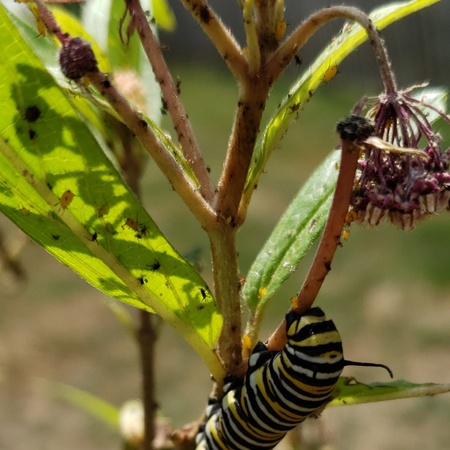
Looks like the aphids are keeping him company LOL. That photo is a good illustration of why gardeners shouldn't spray random bugs on their milkweed. Spraying insecticide to kill the aphids would've killed our monarch cats as well - and they coexist nicely.
Our monarch caterpillars have disappeared! Their chrysalises are probably hidden in the nandina shrub. Good luck guys!
Getting munched didn't harm the swamp milkweed: it's sending out fresh new foliage. Fingers crossed that more caterpillars will appear. If you'd like to support monarchs in your own gardens, swamp milkweed (asclepias incarnata) is an excellent choice. Despite the common name, it doesn't need to grow in a swamp. It's happy in average garden soil with an occasional drink of water in hot weather. It blooms for about six weeks (nectar!) and branches from the four foot tall stems to produce fresh foliage. It seeds about gently if you don't deadhead or mulch but it doesn't spread by runners.
Another milkweed widely available in commerce is butterfly weed (asclepias tuberosa). Butterfly weed is about two feet tall with fine, thin foliage. It thrives in poor, dry soil. Once established it will never need extra water. The orange or yellow flowers arrive in August when the garden could really use some color. I like to mix it with Walker's Low nepeta because the plant forms are complementary. The down side to butterfly weed is the foliage size. Monarch caterpillars are large and voracious. Butterfly weed's thin leaves don't provide much forage for them.
Common milkweed (asclepias syriaca) has the largest leaves and stands tallest at about five feet. It's drought tolerant and happy in average to poor soil. Big leaves, easy to grow, what's not to love? Those big leaves become tough and leathery long before monarchs appear in late July. The coarse texture is visually unappealing in the garden as well. You can trim the stems back in early July and water deeply to promote fresh growth for the caterpillars to munch. Once common milkweed plants become established, they spread by runners to form large stands. That provides even more leaves for caterpillars but it kinda takes over your garden. That's why we are growing swamp milkweed in our library pollinator garden: plenty of tender leaves and an attractive, well behaved plant.
Another hummingbird moth paid us a visit today. Notice how his proboscis is still curled as he settles before feeding. This one was only about 1 inch long, but just as hungry as his larger buddy!

Large carpenter bees are also enjoying the garden today.

Today our gardening consultant mentioned that the color of the pollen baskets or corbiculae can determine where the bees are feeding and gathering pollen.
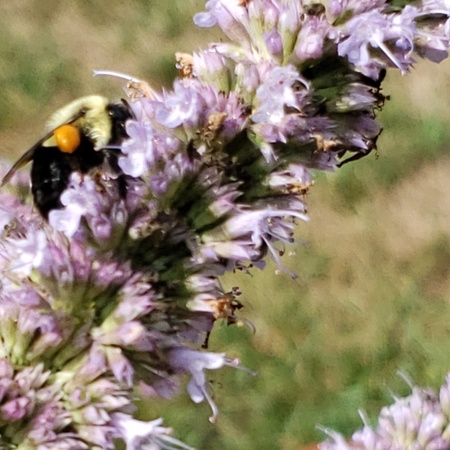
Bees carry pollen back to their hives for food in small pollen pellets, which contain both pollen and nectar, called corbiculae. The long fuzzy hairs on their back legs help them hold the pollen like little tiny saddlebags. The corbiculae can account for nearly 30% of a bees weight!
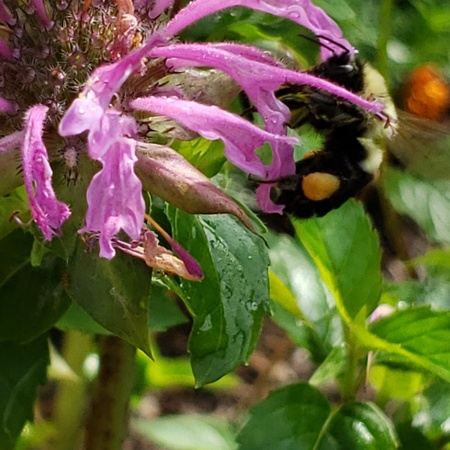
6 Participants
